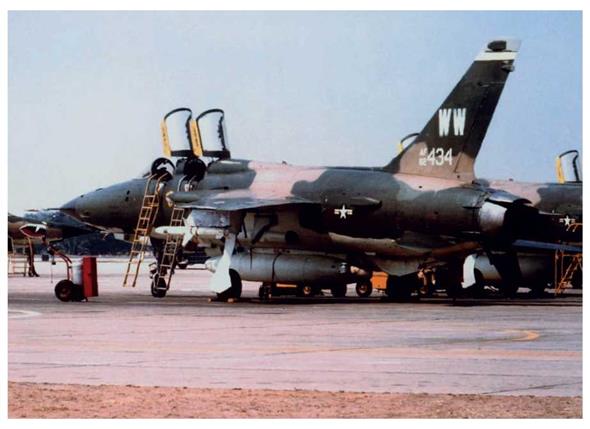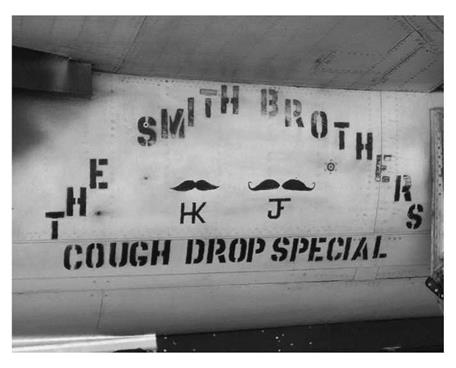STATISTICS AND ANALYSIS
Any discussion of the relative success of the SA-2 in North Vietnamese service compared with US attempts to defeat it is inevitably clouded by the “fog of war”. In most cases, hits by SA-2s were observed by other crews in an American attack formation, but occasionally the speed of the interception, separation of the victim aircraft from other flight members or the wide range of other threats at the time convinced pilots that they had been hit by AAA or MiGs. “Over-claiming” was also a factor in all aspects of the air war, with several SAM sites sometimes laying claim to the same “kill”, or claiming a damaged aircraft as destroyed.
However, the constant depredations of the WildWeasels throughout the war steadily reduced the effectiveness of the SAMs. In 1965 SA-2s were able to destroy one aircraft for every 15 missiles launched. By the end of 1968 this ratio had dropped to one in 48 missiles fired, and the best result during Operation Linebacker IIwas one in 50, despite a huge increase in the number of SAM sites, and in the mobility of SA-2 batteries.
![]() For the Weasel force the price of success was considerable. Between December 1965 and the last F-105G combat sortie in August 1973, two F-100Fs and 46 F-105F/Gs had been lost in the process of destroying or disrupting hundreds of SAM sites. Of these, seven F-105Fs and seven F-105Gs were attributed to SA-2s. In the same period the SA-2 force downed 19 F-105Ds, 15 of them in 1967 alone. Nine were destroyed in the intense attacks between October 27 and November 19, 1967 during strike or Iron Hand sorties at 10,000—20,000ft in daylight. Between November 17 and 19 ten of the 17 US aerial losses were caused by SA-2s. Total losses to SAMs in 1967 were 62 — by far the highest toll of the war years apart from 1972, when no fewer than 72
For the Weasel force the price of success was considerable. Between December 1965 and the last F-105G combat sortie in August 1973, two F-100Fs and 46 F-105F/Gs had been lost in the process of destroying or disrupting hundreds of SAM sites. Of these, seven F-105Fs and seven F-105Gs were attributed to SA-2s. In the same period the SA-2 force downed 19 F-105Ds, 15 of them in 1967 alone. Nine were destroyed in the intense attacks between October 27 and November 19, 1967 during strike or Iron Hand sorties at 10,000—20,000ft in daylight. Between November 17 and 19 ten of the 17 US aerial losses were caused by SA-2s. Total losses to SAMs in 1967 were 62 — by far the highest toll of the war years apart from 1972, when no fewer than 72

 aircraft were downed in the final onslaught, including 17 B-52s. The latter was the highest loss figure to SAMs for any USAF type that year, exceeding the 14 losses of the far more numerous F-4 Phantom IIs.
aircraft were downed in the final onslaught, including 17 B-52s. The latter was the highest loss figure to SAMs for any USAF type that year, exceeding the 14 losses of the far more numerous F-4 Phantom IIs.
Thirty-four F-105F/G aircrew members were killed in action and 22 became PoWs. The cost to SA-2 troops is unknown, but the frequent hits by cluster bombs and other ordnance must have taken many lives.
Overall, fixed-wing US losses to SAMs amounted to 205 (against North Vietnamese claims of 1,293 kills), including nine forward air control aircraft and one AC-130A to hand-held SA-7 “Grail” short-range missiles. Although this is a comparatively small proportion of the 3,322 losses (with 3,265 fatalities) to all causes, the effect of the SAM threat has to be measured in terms of its deterrence and disruption too.
The addition of SEAD flights to every strike in a high-threat area added to the cost and complexity of the missions, and diverted aircraft that could have been used to bomb primary targets. Aircraft ordnance pylons that could have carried extra bombs had to take ECM pods instead, or AIM-9 missiles to tackle MiGs. More importantly, the presence of SA-2s caused many strikes to be partially or wholly aborted as the attackers evaded interception. Indeed, many B-52 Arc Light missions were recalled prior to Linebacker II, when SA-2 sites were moved into Laos and southern North Vietnam. SAC was understandably anxious to preserve the myth of invincibility
surrounding its primary nuclear bomber, and it did not want the communist world to see that its ECM protection was not completely SA-2 proof.
For the F-105 and F-4 strike packages of Rolling Thunder, the only defense against imminent MiG or SA-2 interception was the jettisoning of ordnance to provide the speed and maneuverability to give the pilot a chance of escape, thereby negating the purpose of the mission.

 |
In the two peak years of activity, SA-2 sites engaged US aircraft on 1,104 occasions in 1967 and 1,135 times in 1972. However, they too paid heavily. Of the 95 batteries of SA-2s (7,658 missiles) provided by the Soviet Union, only 39 remained in January 1973, with a little over 800 missiles available — some of which were unserviceable.
![]()


Another 200 were destroyed on the ground. Although US pilots reported almost 9,000 SA-2 launches, some could have been multiple reports of the same missiles for the North Vietnamese recorded only 5,800 launches.
The growth of North Vietnam’s air defense network was rapid, beginning with a few P-8 and P-10 early warning radars in 1961 and expanding to 22 sets by early 1964, with a large number of AAA guns with “Fire Can” (SON-9) and “Whiff” fire control radars to guide them. The first SA-2 site was detected by a US Navy RF-8A Crusader on April 5, 1965, and 63 others had been identified by the end of that year. This figure had risen to 150 by the end of 1966, and they were used by 30 SA-2 batteries travelling between the sites.
Despite the urgency generated by Brig Gen Kenneth Dempster’s anti-SAM program in the late summer of 1965, no F-105F Wild Weasels were available for deployment to Thailand until May 1966. The systematic training of Wild Weasel tactics also began at this time too with the introduction of four-week courses at Nellis AFB’s 4537th Fighter Weapons Sschool. Unlike the SA-2 crews in-theater, the early Weasels were using largely untested equipment and evolving tactics in situ, with a small number of aircraft and crews facing highly experienced Soviet missile operators with plentiful supplies of a battle-tested missile system.
Only 63 F-105Fs were converted to WildWeaselconfiguration, including the two prototypes. Of these, 11 were combat losses and four were destroyed in operational accidents from a total casualty figure of 46 F-105F/Gs involved in anti-SAM activity and five during other attack sorties.
When the first F-105G shoot-down occurred on January 28, 1970, 28 F-105Fs, including two Combat Martin and three “Ryan’s Raiders” aircraft, had already been
lost, denying them to the WildWeasel conversion program. In addition, around 15 jets were retained in the USA for training and test work. With a total production of 143 F-105Fs and no prospect of extra F-105G batches, the pressure on the small Weasel force was considerable, particularly as its intended replacement, the F-4C WildWeasel IV, proved to be less capable than the F-105G.
Their sortie rates were impressive. Between March 1, 1967, and March 31, 1968 (one of the most difficult phases of Operation Rolling Thunder), 931 Iron Hand sorties were flown, 1,146 AGM-45 Shrikes were fired and 370 “Fan Songs” were claimed as destroyed or damaged. In return only two F-105Fs were lost in specific Wild Weasel missions at that time, but 12 other F-105Fs were destroyed in “hunter-killer” SAM attacks on 40 sites, and no fewer than 85 F-105Ds were downed, some also during Iron Hands. Additional to the destruction of “Fan Songs” was the even more important suppression element in the Iron Hand/Wild Weasel effort. USAF evaluators estimated that SA-2 launches decreased by up to 90 per cent when F-105Fs were on station.
During Linebacker II, in support of 741 B-52 sorties, USAF and US Navy SEAD aircraft fired no fewer than 421 Shrikes, half of them pre-emptively (to force “Fan Songs” to close down), and 49 AGM-78s against an estimated 200 SAM launchers. Only two AGM-78s and one Shrike were confirmed hits on “Fan Songs”, but SAM radars were closed down on 160 occasions, reducing the destructive effect of many of the 850 SA-2s launched.
An increased use of pre-emptive launches also accounted for 320 of the 678 Shrikes fired in the period April-October 1972, when only one definite hit (and 59 “possibles”) was recorded. The 230 AGM-78s fired during that period scored two definite kills and 37 possible hits, but reduced the 388 th TFW’s stock of the missiles to 15 by the fourth night of the campaign, increasing the need for CBU-carrying F-4Es despite heavy cloud cover on several nights. Although 380 of these launches in all were calculated as “misses”, their effect in shutting down enemy radars was considered valid, reflected in the steady decline in the rate of aircraft losses to SAMs throughout the war.
The SA-2 regiments were also running very short of missiles by the fifth night of the campaign. Once sites had fired their complement, new SA-2s had to be fetched by transloader vehicles from depots that were hidden in urban areas around Hanoi and Haiphong, and there were very small stocks of ready-assembled missiles left by the end of December 1972.
While pre-emptive launching had been the basis of the US Navy’s SEAD policy throughout the conflict in Vietnam, the USAF continued to rely on specialized Wild Weasels as a surer means of identifying, suppressing or destroying sites. In the words of the 388th TFW Tactics Manual:
The actual destruction of SA-2 sites is normally of secondary importance in the suppression role, and would not normally be carried out unless a particular site could be destroyed without sacrificing the protective suppression the strike force requires from other threatening sites. However, for particular targets, SA-2 site destruction may be the
best and most permanent form of suppression. 75










